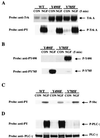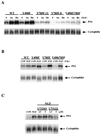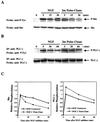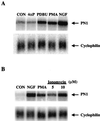Sustained signaling by phospholipase C-gamma mediates nerve growth factor-triggered gene expression
- PMID: 11283249
- PMCID: PMC86900
- DOI: 10.1128/MCB.21.8.2695-2705.2001
Sustained signaling by phospholipase C-gamma mediates nerve growth factor-triggered gene expression
Abstract
In contrast to conventional signaling by growth factors that requires their continual presence, a 1-min pulse of nerve growth factor (NGF) is sufficient to induce electrical excitability in PC12 cells due to induction of the peripheral nerve type 1 (PN1) sodium channel gene. We have investigated the mechanism for this triggered signaling pathway by NGF in PC12 cells. Mutation of TrkA at key autophosphorylation sites indicates an essential role for the phospholipase C-gamma (PLC-gamma) binding site, but not the Shc binding site, for NGF-triggered induction of PN1. In concordance with results with Trk mutants, drug-mediated inhibition of PLC-gamma activity also blocks PN1 induction by NGF. Examination of the kinetics of TrkA autophosphorylation indicates that triggered signaling does not result from sustained activation and autophosphorylation of the TrkA receptor kinase, whose phosphorylation state declines rapidly after NGF removal. Rather, TrkA triggers an unexpectedly prolonged phosphorylation and activation of PLC-gamma signaling that is sustained for up to 2 h. Prevention of the elevation of intracellular Ca2+ levels using BAPTA-AM results in a block of PN1 induction by NGF. Sustained signaling by PLC-gamma provides a means for differential neuronal gene induction after transient exposure to NGF.
Figures









Similar articles
-
Molecular dissection of TrkA signal transduction pathways mediating differentiation in human neuroblastoma cells.Oncogene. 2000 Apr 13;19(16):2043-51. doi: 10.1038/sj.onc.1203518. Oncogene. 2000. PMID: 10803465
-
Nerve growth factor stimulates the tyrosine phosphorylation of a 38-kDa protein that specifically associates with the src homology domain of phospholipase C-gamma 1.J Biol Chem. 1992 Oct 25;267(30):21601-6. J Biol Chem. 1992. PMID: 1400471
-
The selective and inducible activation of endogenous PI 3-kinase in PC12 cells results in efficient NGF-mediated survival but defective neurite outgrowth.Oncogene. 1999 Aug 12;18(32):4586-97. doi: 10.1038/sj.onc.1202814. Oncogene. 1999. PMID: 10467403
-
Auricular Vagal Nerve Stimulation Inhibited Central Nerve Growth Factor/Tropomyosin Receptor Kinase A/Phospholipase C-Gamma Signaling Pathway in Functional Dyspepsia Model Rats With Gastric Hypersensitivity.Neuromodulation. 2024 Feb;27(2):273-283. doi: 10.1016/j.neurom.2023.01.007. Epub 2023 Feb 16. Neuromodulation. 2024. PMID: 36801128
-
NGF and ProNGF: Regulation of neuronal and neoplastic responses through receptor signaling.Adv Biol Regul. 2015 May;58:16-27. doi: 10.1016/j.jbior.2014.11.003. Epub 2014 Nov 20. Adv Biol Regul. 2015. PMID: 25491371 Free PMC article. Review.
Cited by
-
Biogenesis and function of the NGF/TrkA signaling endosome.Int Rev Cell Mol Biol. 2015;314:239-57. doi: 10.1016/bs.ircmb.2014.10.002. Epub 2014 Nov 18. Int Rev Cell Mol Biol. 2015. PMID: 25619719 Free PMC article. Review.
-
FK506 potentiates NGF-induced neurite outgrowth via the Ras/Raf/MAP kinase pathway.Br J Pharmacol. 2003 Nov;140(5):825-9. doi: 10.1038/sj.bjp.0705522. Epub 2003 Oct 14. Br J Pharmacol. 2003. PMID: 14559856 Free PMC article.
-
Human carbonic anhydrase-8 AAV8 gene therapy inhibits nerve growth factor signaling producing prolonged analgesia and anti-hyperalgesia in mice.Gene Ther. 2018 Jul;25(4):297-311. doi: 10.1038/s41434-018-0018-7. Epub 2018 Apr 24. Gene Ther. 2018. PMID: 29789638 Free PMC article.
-
Osmotic perception of GABAergic synaptic transmission in the supraoptic nucleus of rats.IBRO Rep. 2020 Jul 2;9:58-64. doi: 10.1016/j.ibror.2020.06.007. eCollection 2020 Dec. IBRO Rep. 2020. PMID: 32685762 Free PMC article.
-
Pincher, a pinocytic chaperone for nerve growth factor/TrkA signaling endosomes.J Cell Biol. 2002 May 13;157(4):679-91. doi: 10.1083/jcb.200201063. Epub 2002 May 13. J Cell Biol. 2002. PMID: 12011113 Free PMC article.
References
-
- Altar C A, DiStefano P S. Neurotrophin trafficking by anterograde transport. Trends Neurosci. 1998;21:433–437. - PubMed
-
- Barbacid M. Neurotrophic factors and their receptors. Curr Opin Cell Biol. 1995;7:148–155. - PubMed
-
- Berg M M, Sternberg D W, Parada L F, Chao M V. K-252a inhibits nerve growth factor-induced trk proto-oncogene tyrosine phosphorylation and kinase activity. J Biol Chem. 1992;267:13–16. - PubMed
-
- Bonni A, Ginty D D, Dudek H, Greenberg M E. Serine 133-phosphorylated CREB induces transcription via a cooperative mechanism that may confer specificity to neurotrophin signals. Mol Cell Neurosci. 1995;6:168–183. - PubMed
-
- Bourne H R, Sanders D A, McCormick F. The GTPase superfamily: a conserved switch for diverse cell functions. Nature. 1990;348:125–132. - PubMed
Publication types
MeSH terms
Substances
Grants and funding
LinkOut - more resources
Full Text Sources
Other Literature Sources
Miscellaneous
